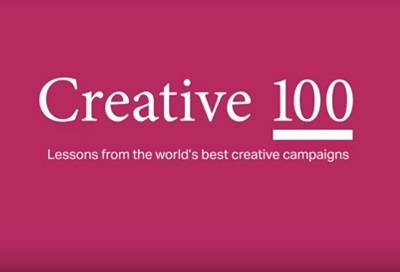WARC Creative 100: The 3 key lessons from the world’s best campaigns
Using purpose to power behavioural change, involving customers to drive brand engagement and weaving creativity into the customer experience, are the three main themes, finds WARC, following its analysis of the world’s most creative campaigns.
WARC, which provides the latest evidence, expertise and guidance to make marketers more effective, has released ‘Creative 100 - Lessons from the world’s best campaigns’, a report analysis of the campaignsranked in the WARC Creative 100, to uncover trends from the latest creative strategies as well as bringing together insights and opinion from the creators of award-winning ideas.
Amy Rodgers, Research Editor, WARC, and author of the report, said, “We have deep-dived into the Creative 100 rankings to provide learnings from creative successes that will inspire and lead the way to greater creativity.”
The three key trends from the WARC Creative 100 are:
Purpose-led strategies evolve
The use of purpose as a driver for marketing strategies continues to be a regular feature of the top creative campaigns, and was central to the number one campaign, Palau Pledge, which created an immigration policy for the island of Palau to protect the nation from environmental damage.
Whilst purpose has become commonplace, several brands in this year’s Creative 100 evolved their purposeful messaging, from driving awareness to encouraging consumers towards behavioural change.
In campaigns with this approach, the brand purpose was actually actioned by customers themselves, driving engagement through participation and subsequent diffusion of conversation.
Alex Grieve, Executive Creative Director, AMV BBDO, remarked, “What’s interesting about the evolution of purpose towards changing behaviour is that it mirrors a broader trend in marketing. In asking people to affect change, brands have realised they too need to change.”
Casting customers
Directly involving customers in campaigns, whether to drive behavioural change or to drive brand engagement is a key theme from the Creative 100. This year’s most creative brand, Burger King, had its customers dress up as clowns in a campaign that trolled its competitor’s mascot, Ronald the Clown. Skittles cast one superfan as the star of its Superbowl campaign (ranked #4) and Marmite (#7) asked their customers to take a DNA test.
Participation elements can turn ads into acts, and in a low-attention economy, this approach has become an important way of gaining attention.
Martin Beverley, Strategy Director, adam&eveDDB, commented, “Many ideas in the WARC Creative 100 aren’t just ads, they’re acts – designed to impact popular culture and make a dent in the real world.”
Creativity across the experience
Rather than seeing a campaign as an entity existing on a single channel, this year some of the most awarded brands created experiences where the creative idea was woven into every element of the purchase journey, building customer executions across multiple channels to work at those moments.
Bodyform’s ‘#Bloodnormal’ (ranked #2) a social idea at its heart, used influencers, designers and stylists to create visual pieces to champion a cause and rightly played in the channels where consumers could share and support. Tide’s ‘It’s a Tide Ad’ (ranked #5) used traditional media in an innovative way, highjacking the brand awareness generated by other ads, and turning it into awareness for Tide whilst creating a choreographed brand experience. A similar approach was used by Budweiser in their Tagwords campaign (#32), which harnessed print and outdoor to drive the audience to online search.
These brands created experiences for consumers, who then actively wanted to engage.
Kate Stanners, Chairwoman and Global Chief Creative Officer, Saatchi & Saatchi, observed, “This to me is modern storytelling. All three campaigns explored the possibilities of the channels they were in. Weaving from real physical spaces to virtual experiences creating more powerful and lasting connections with their audience.”
The WARC Creative 100, successor to the Gunn Report, is part of WARC Rankings, which tracks the winners’ lists from the most important advertising award contests, globally, as determined by the industry. The results of creative competitions are used to compile the WARC Creative 100, which is built on a rigorous methodology, used consistently across the competitions tracked.






Share
Facebook
YouTube
Tweet
Twitter
LinkedIn